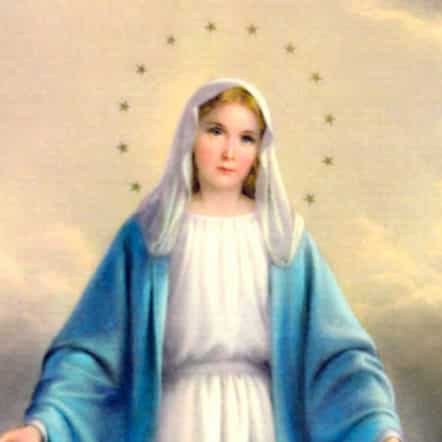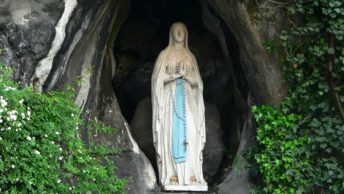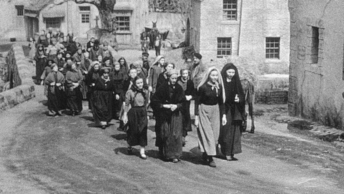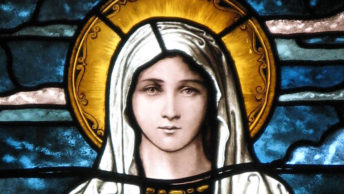The Catholic Church celebrates the Feast of the Assumption on August 15 and the dual symbolism of that date has rendered a particular framing of memory of the 1920 victory. In the commemorative narrative fostered by the Church in distant Poland, the victory is portrayed as a divine miracle and evidence of God’s providence. The attribution of the victory to Divine Providence was confirmed in the common belief by a whole series of visions whereby Our Lady of Grace, Patroness of Warsaw, put a halt to the Red Plague. A prototype being the image’s motive, which can be found in Italian Faenza, shows the Virgin Mary holding broken arrows which symbolize protection against God’s wrath and promise an end to the plagues.
From the very beginning, the fact of the double appearance of the Virgin Mary has been mercilessly lampooned by the enemies of the Church in all their guises. Especially, members of freemasonry relentlessly attempt to make us live with a false past, the past from which all sorts of traces of God’s presence must be screened out. Without a doubt, nobody in his right mind could challenge the statement of Primate of Poland, the Servant of God, August Hlond that “Józef Pilsudski deserves the eternal gratitude of the Polish citizens and the whole of Christianity.” However, the primary source of the stupendous victory lies in Our Lady’s intervention, preceded by fervent national prayer.
It was a war of a Catholic nation against an army of an atheist, materialist creed, where the winning was against all impossible odds; and the Poles were painfully aware of this. Moreover, for many of them, anything imported from the east was automatically tainted by association with Poland’s historic oppressor and occupier, Russia. All in all, people realized that only a miracle could save her from total annihilation. In churches across Poland, the faithful of various walks of life confessed their sins, received Holy Communion, and adored Jesus in the Blessed Sacrament. Over 100,000 Poles took to the streets to beg for God’s Mercy. General Józef Haller lay prostrate before the image of the Black Madonna on the floor of Church Christ the Savior. Likewise did 30,000 of the gathered in Castle Square who also wept and prayed the Rosary throughout the night in front of the relics of a martyr and patron saint of Poland – Andrzej Bobola, and a patron saint of Warsaw – Władysław of Gielnów. Understanding the gravity of the situation Nuncio Archbishop Achille Ratti (later Pope Pius XI) appealed for worldwide public prayers for Poland. As the hordes of evil empire crossed the river Bug Polish bishops joined to consecrate their country to the Sacred Heart of Jesus at Jasna Góra.
The 19th century Polish mystic, the Servant of God, Wanda Malczewska in a private revelation obtained this prophetic message: “As soon as Poland regains her independence, shortly her long-standing oppressors will rise against her. But my young army, fighting in my name will overcome them, push them far away and finally will force to make peace. I will help them.”
The first appearance of Our Lady took place on the 14th of August. At about 3:30 in the morning, the Bolsheviks started the offensive and easily overran the Polish positions. The murderous fire of their machine guns ruthlessly mowed down fleeing young and inexperienced Polish soldiers. Many of them were scouts and students of Warsaw schools who a few days before volunteered to defend their homeland. Seeing chaos and terror in the eyes of the lads, Father Ignacy Skorupka, moved by internal inspiration, led the extended line to meet the wheezing bullets of the enemy. He moved ahead, holding a wooden crucifix, meeting his death, uttering “for God and for homeland” on the outskirts of Ossowo village. Nobody expected that this would be a turning point in the battle at that section of the front line. From that moment on, the Soviets did not retreat but fled panic-stricken. All available reports say that the Red Army troops beheld Our Lady of Grace, exactly as is set out in the image at the Jesuit church in Warsaw.
The second appearance occurred in the small hours on the 15th of August during a night charge of Lieutenant Stefan Pogonowski at two different locations in the proximity of the villages Mostki Wólczanskie and Wólka Radzymińska. Awakened by a sudden fusillade, the Red Army troops were truly terrified. They saw the formidable figure of a woman wafting above the heads of the attacking Polish battalion. A streak of divine light illuminated her, making her well visible in the darkness. There was a halo around her head. The lapels of her navy-blue-hued coat flying in the wind shielded the battle stations of the Poles. The woman wielded a sort of shield, deflecting the Soviet bullets which returned and exploded exactly where the Soviet reserves were stationed. This awe-inspiring phenomenon was exacerbated by the presence of a heavenly person accompanied by detachments of horseback knights. The local Poles were only able to discern a heavenly glow in the sky.
In 1970, on the fiftieth anniversary of the Battle of Warsaw, the Polish Episcopate prepared a pastoral letter entitled “On the Anniversary of God’s Great Love” and bishops showed gratitude to The Mother of God Queen of Poland for her intercession to God on Poland’s behalf in 1920. The letter was not disseminated.
On May 3, 2020, another half of a century later, the President of the Polish Bishops Conference, Archbishop Stanislaw Gądecki, made a solemn act of consecrating Poland to the Sacred Heart of Jesus and the Mother of God, Queen of Poland. He thanked God Almighty for saving the homeland and European civilization from the Bolshevik’s reign through the intervention of the Blessed Virgin Mary. Unsurprisingly, all mainstream Polish media glossed over the event.
Pope John Paul II visiting the town of Radzymin in 1999, reminded the assembled of meaningful words: “That was a great victory of the Polish army, so big, that it cannot be explained solely in a natural way…”. He went on saying “There has been a conspiracy of silence concerning the great Miracle on the Vistula for years.”
Similarly, President Andrzej Duda, in his speech delivered in a square bearing the name of Marshal Józef Piłsudski, gave utterance: “It was a great victory near Warsaw, the one we call the Miracle on the Vistula River – above all, it was a miracle of the genius of Polish commanders, but we firmly believe that the protection of the Blessed Mother of God over our Home Country was also important.” Another time, the President remarked: “the Lord’s and Our Lady’s intervention which supported her lads, her children, allowed them to protect against the Soviet red onslaught (…), this was one of the key elements in the success.”
Cardinal Aleksander Kakowski committed the following words in his diary: “Young soldiers whom I visited in a hospital for the wounded were telling me the details of Fr. Ignacy Skorupka`s death. Meanwhile the captured Bolsheviks recounted the Mother of God above a priest vested in surplice and holding a cross.”
Fr. Zdzisław Król, who died in the Smolensk coup of April 10th, 2010, cited the testimony of a landlady from a village near Radzymin who had spoken with an awed red army soldier witnessing the Mother of God rebound bullets.
Fr. Wiktor Mieczkowski, the parish priest of St. Giles in Wyszków wrote down in the book entitled “Bolszewicy w polskiej plebanii” – “a priest working in a military hospital revealed that Russian soldiers had assured him of having seen Our Lady shield the capital of Poland, Warsaw. Similar testimonies were coming from varies places.”
On the 14th of October, 2008, Fr. Dr. Józef Bartnik S.J., on the air of Radio Maryja uttered: “From the beginning of pastoral work at the Shrine of Our Lady of Graces […] penitents started coming to me saying that pieces of information on the appearance of Our Lady during the Battle of Warsaw in 1920 had been handed down through generations in their families. They indicated that the figure of Mary, who had appeared to the Bolsheviks, bore the resemblance of the Patroness of Warsaw.” According to Fr. Bartnik, who worked for 30 years at the Jesuits` sanctuary, there were Polish witnesses who met terrified, teeth chattering, bug-eyed almost insane Red Army soldiers begging to be hidden from the ‘Tsarina’ – the Mother of God (Matier Bożju).
Bishop Józef Zawitkowski, in the homily delivered on June 9, 2017, brought up the testimonies of peasants whom fleeing Russian soldiers told that they had seen Our Lady shield the Poles. Bishop Henryk Hozer announced on August 14, 2013, that the “Victory in the battle of Warsaw was the result of a threefold miracle.”
Karolina Gruc, conveys us a captivating story. “On the 15th of August at dawn Władysław and his wife Józefa, both landlord and landlady from a village near Radzymin were awakened by two barking mongrels. Ignoring the calls of their master the dogs stubbornly stood next to a kennel and keep barking frantically. […] At his command a tearful, scared-stiff young man crawled out of the kennel crying out in Russian “We have seen the Mother of God.” This gripping narrative heard by Władysław was corroborated by other people: countrymen, doctors and paramedics who had picked it up from Russian deserters and POW’s.
Wincenty Łaszewski, Doctor of theology and Mariologist, argues that “The Miracle on the Vistula was the fruit of the prayer of a united Polish people.”
Fr. Wiesław Wiśniewski found among the memoirs of his great-grandfather, Bolesław, the following passage: “About August 20, the Bolshevik forces disorderly retreating appraised their incessant march as quite easy. Not until they reached the suburbs of Warsaw did they realize they had completely lost the ability to command and the will to fight. Finally, they failed to capture the city claiming they had seen the Mother of God above it hence they immediately relinquished the idea of assailing her.”
As we can conclude from Marshal Pilsudski’s memoirs “Rok 1920” reading a passage which in a very forcible way sums up extraordinary situation: ”It seemed to me as if I had been in a dream, in the world of an enchanted story. I was not able to discern whether it was a dream or truth […] Did I dream then […] or am I dreaming right now as five divisions are moving freely and without resistance through these spaces which so recently […] fell into enemy hands. Where is the 16 [Bolshevik] Army? I was going to Minsk and saw abandoned cannons in a field without a team, plentiful corpses on both sides of a road […] local people testified that they had met the Bolsheviks fleeing in panic in different directions.”
The Virgin Mary may be perceived as the light at the end of the tunnel. Today’s world more than ever before needs people of unshakable faith who would seek recourse to her – the Mediatrix. As the Second Vatican Council stressed in Lumen gentium: “Mary’s function as the Mother of men in no way obscures or diminishes this unique mediation of Christ, but rather shows its power.” As no one else, Our Lady of Grace is capable of setting us free from the variety of plagues presently affecting the entire humanity.
The 1920 Miracle on the Vistula, which is virtually unknown to English-speaking audiences, represented that rare thing in history: a moment of supernatural interference in the vicissitudes of nations, akin to the Miracle of Lepanto in 1571 and the Duel of David with Goliath. (1 Samuel 17)
“Victory in battle does not depend on who has the largest army; it is the Lord’s power that determines the outcome.” (1 Maccabaeus 3:9)








